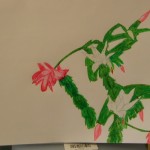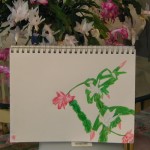CREATIVITY = THINKING OUTSIDE THE BOX = PARADIGM SHIFTS
PRISMS/S PROBLEM SOLVING PROCESS AND PARADIGM SHIFTS
Creative genius includes thinking “outside the box,” setting aside preconceived concepts and ideas and being able to “look at” a problem from a totally new angle. Actually, this “looking at” is really the “sitting with” the “intuitive feel,” the fresh, present “felt experiencing” that underlies existing concepts and can lead to the articulation of new, non-linear, creative ideas. Gendlin’s Focusing (Bantam, 1981, 1984), and Dr. McGuire’s Intuitive Focusing, are the pre-eminent approaches for setting aside existing preconceptions, and finding and “sitting with” fresh, preverbal experiencing, the hotbed of new ideas and creative solutions. Below I review some traditional methods for “shaking up” old structures to allow new ideas to become available, then I add the Intuitive Focusing skill into the mix.
In his e-newsletter, The Simple Truth’s Newsletter,Mac Anderson reviews cutting-edge models for increasing creativity and innovation. In the newsletter quoted below, he leads to a link to a beautiful, three-minute video clip which exactly captures the essence of “the paradigm shift”:
“Dear Kathy,
Tom Peters gets it. He said…
“I’ve spent a good part of my life studying economic successes and failures. Above all, I’ve learned that everything takes a back seat to innovation.”
Tomorrow comes at us with lightning speed, and your competitive advantage is a fleeting thing. As leaders, we must create an environment that puts innovation front and center. Your people must know it is the key to your company’s survival.
You must create a climate that rewards risk and creative effort. Your people must not fear mistakes, but understand that honest mistakes can be life’s main source for learning.
SO TEACH THEM TO FAIL QUICKLY, AND OFTEN, TO ENABLE THEM TO REACH THE NEXT PLATEAU.
Every now and then a simple book comes along that deals with a profound subject in an unforgettable way. Paper Airplane is that book; and it teaches a valuable lesson about courage and creativity for people of all ages. It takes less than 30 minutes to read, but the “a-ha moments” are priceless. It’s one of my all time favorites.
So, if you haven’t seen Michael McMillan’s 3 minute inspirational movie titled Paper Airplane, you’re in for a treat! Just click on the link below and share it with friends and co-workers. http://www.paperairplanemovie.com/ “
Usually, consultants coming in to help corporations with “creativity and innovation” provide a variety of games and other experiences which allow participants to “drop” or “step out of” existing schemata and access the fresh, new pre-verbal experiencing from which new paradigms can be articulated. Here is an introduction to one such “package” of “shake up” exercises:
“WHAT THE CATERPILLAR CALLS THE END OF THE WORLD, GOD CALLS A BUTTERFLY
If you always think the way you’ve always thought, you’ll always get what you always got. The same old, same old ideas over and over again. The future belongs to those thinkers who embrace change, break new ground, forge new paths, and transform the way they think. Discover how to look at the same information as everyone else and see something different by using the creative thinking techniques and strategies that creative geniuses have used throughout history.
Internationally acclaimed creativity expert Michael Michalko’s Thinkertoys: A Handbook of Creative Thinking Techniques have inspired business thinkers around the world to create the innovative ideas and creative strategies they need to achieve unimaginable success in today’s changing business environment of complexity and uncertainty. Change the way you look at things and the things you look at change. [Available at www.amazon.com, Barnes & Noble, and most major bookstores. Visit www.creativethinking.net for more detailed information on these inexpensive workbooks.]”
DeBono’s Six Thinking Hats, and Parallel and Lateral Thinking (description of trainings and books to purchase) approaches are at the cutting-edge of creavity as breaking out of old structures, accessing the new.
Mind Mapping Techniques (http://www.mindmapper.com/?gclid=CMHz54C975ICFQJtlgodQT-75w for a complete description) are another method for breaking out of linear thought structures and allowing the presentation of facets of problem/solution from the non-linear, “intuitive feel” of “the whole thing.” Intuitive Focusing: “Direct Access” to Paradigm ShiftingAs I presented last week, Flavia Cymbalista has helped George Soros and others dealing with the complexity and uncertainty of financial markets to use Gendlin’s Focusing to articulate from the “intuitive feel” in her Market Focusing approach at www.marketfocusing.com .
While games and exercises can “shake up” thinking from the outside in, at some point, the “new” answer emerges because someone in the group becomes free of old concepts and able to access The Creative Edge, the preverbal “felt sensing” of new possibilities. Intuitive Focusing allows anyone to access the Creative Edge of new, non-linear problem solving at any time.Rather than looking to the outside for new ideas, the Focuser goes inside, getting in touch with the raw, new, “preverbal” complexity of situations from which new solutions, Paradigm Shifts, emerge.
Reflecting Before Acting or Reacting
The radical contribution of Gendlin’s Focusing (Bantam, 1981) and McGuire’s Creative Edge Focusing ™ is that the problem solver makes the explicit choice to pause and take some moments for silent reflecting before acting or reacting. Instead of simply repeating past reactions, the Focuser can create new, completely innovative solutions and behaviors from the “intuitive feel” of the whole situation.A quiet pause is needed in order to sense into the “intuitive feel,” The Creative Edge, of problems. Whether in private or in group decision making settings, these opportunities for pauses to contact and articulate the Creative Edge are what allow the creation of totally new ideas and solutions. No pauses, no creation of the new!!!!!Using the PRISMS/S Problem Solving Process is like passing light through a prism. A few moments of pondering, and The Creative Edge opens into a whole spectrum of new possibilities and action steps.
Pausing To Ponder: From Problems To Possibilities
The PRISMS/S Problem Solving Process includes seven ingredients of predictable “Ahah!” experiences using Creative Edge Focusing ™. With its Core Skills of Intuitive Focusing and Focused Listening , PRISMS/S is based upon Eugene Gendlin‘s “A Theory of Personality Change” (link to Gendlin Online Library at www.focusing.org, where you will find all of Gendlin’s articles for free download) and his Focusing self-help book (Bantam, 1981), as well as Dr. McGuire’s thirty years of experience integrating Listening/Focusing skills into task-oriented groups and supportive communities.
PRISMS/S is Dr. McGuire’s attempt to create an easily teachable rubric, especially applicable to business settings, combining Gendlin’s 6-Step Focusing Process with the unfolding steps of change, the “felt shift,” or “paradigm” shift facilitated by Focusing.
PRISMS/S can be used on one’s own or with the help of Focused Listening in a Creative Edge Focusing Partnership, Focusing Group or Team, or Focusing Community. In any case, problem solving goes through the following steps:
Pausing : Clearing A Space for Problem Identification
Reflecting: Listening To Oneself or Focused Listening from Another
Intuitive Focusing: Back-and-Forth Between Symbols and Intuition
Shifting: The Kaleidoscope Turns And A New Paradigm Arises
Movement: Innovative Solutions and Action Steps Arise Spontaneously
Satisfaction: Tension Releases in the Sureness of “Ahah! That’s It!”
Support: Listening/Focusing Partnerships Build Empathy and Community
Click here to read and download the complete description of the steps of PRISMS/S from www.cefocusing.com. You will find there a link to the Spanish translation as well.
Focusing Partnerships, Groups/Teams, Communities
While anyone can learn to use PRISMS/S for creative problem solving on one’s own, the process can be greatly facilitated by having an outside Focused Listening Partner. Read about all the options for Focusing Alone, Focusing Partnership, Focusing Groups/Teams, etc. under Case Studies at www.cefocusing.com .
If you do not have a Listening/Focusing Partnership, consider whether there is a colleague at work, a friend or family member who is already an excellent listener and might be interested in learning the formal Listening/Focusing Partnership method with you. Then, use the multi-media materials in our Self-Help Package or the free download of Chapter Three: The Listening/Focusing Exchange (a link at the top of this blog entry ). You can also enroll in Listening/Focusing Classes/Workshops internationally with Certified Focusing Professionals or bring in Creative Edge Consulting for onsite training.
The Blurry, Vague, “Feel of the Whole Thing” Holds The Next Steps
I invite you to use Intuitive Focusing again below to find next steps on a “creative project”: an article, a book, a poem, a song, a dance, a marketing campaign, an engineering breakthrough, some project needing creative ideas.
If you need to work more specifically on “blocks” to creativity, you could use Cornell and McGavin’s technique from last week, using Focusing to give a gentle hearing to the “part” that wants to “hold back,” as well as the “part” that wants to “go forward,” until steps toward resolution arise (Week Two Treasures In Blocks).
Focusing On A Creative Problem or Project
Click here to find the complete Intuitive Focusing exercise in e-newsletter archives
Remember, it is often easier to learn Intuitive Focusing with the company of a Focusing Listener. See links below to find many resources, including self-help groups, and Creative Edge Focusing Consultants for individual Coaching or Classes and Workshops.
Download complete Instant “Ahah!” Mini-Manual, in English and Spanish, from CEF Website
Find links to free articles, personality tests, multi-media Self-Help training, Classes and workshops
Dr. Kathy McGuire, Director
The site of new insights and creative solutions is at the edge of what is already known. This edge, The Creative Edge, holds implicit within it all past and future knowing about the problem, more than could ever be put into words in a linear way


